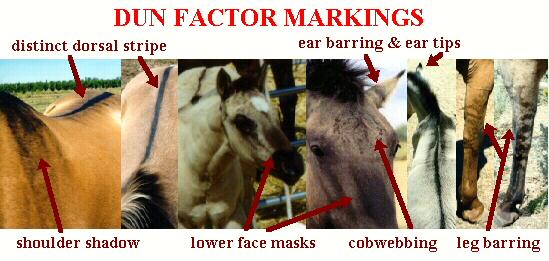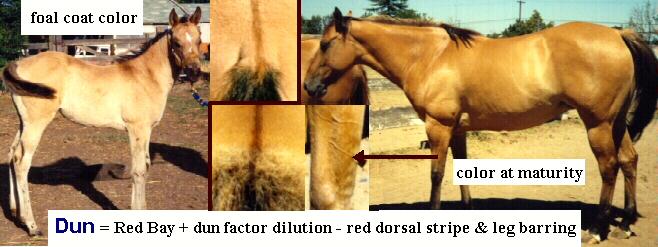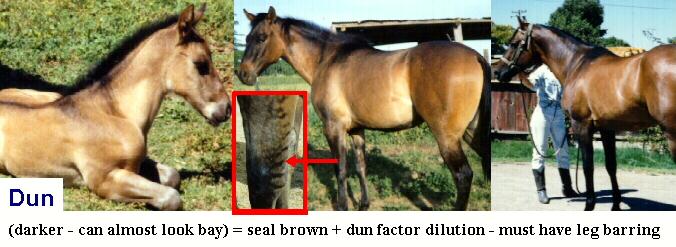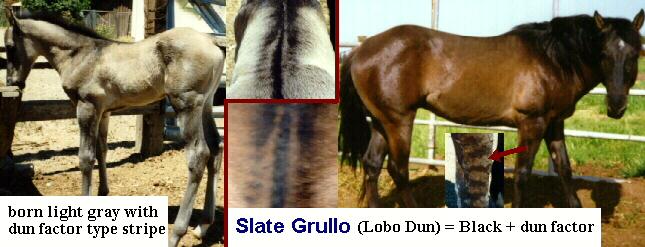Dun Factor Striping and Foal Coat Colors
By J. Sharon Batteate
The Dun gene changes bay into "dun". As there are many shades of bay, you can have many shades of dun. The lighter shades of bay will become a yellowish gold colored body with darker undiluted points, dorsal stripe, and leg barring, which some people still think of as a "buckskin". Sorrel, chestnut, and liver chestnut become "red dun", in which the body color is pinkish/yellowish or flesh colored with red to liver chestnut colored mane, tail, dorsal stripe, and leg barring (some people call the lighter shades claybank duns). Black and dark brown become one of the many "blue dun" / "grulla" / "grullo" shades (mouse gray or brownish gray in which each hair is gray, not a mixture of white and dark hair which also looks gray). Unlike the "c cr" dilution, there is no double diluting effect if a horse carries two copies (double dose, homozygous) of the "D" gene, so you won't get a cremello from "D" gene breeding. People often add other adjectives to describe the different shade of dun, such as buttermilk, silver, lobo, apricot, lilac, etc., which can sometimes cause confusion in people's minds. Just remember there are three basic classes as described above: Dun Red Dun
Red Dun Blue Dun (grullo). Dun can also interact with other genes. For example, you can have a dun paint, a red dun roan, or a grulla appaloosa, and it can interact with the other dilution genes, giving some unusual color combinations, such as the dunalino, also called a linebacked palomino, which is a combination of "dun" and "c cr" dilutions. There are some pictures in the article on the "c cr" (palomino / buckskin / cream) dilution.
Blue Dun (grullo). Dun can also interact with other genes. For example, you can have a dun paint, a red dun roan, or a grulla appaloosa, and it can interact with the other dilution genes, giving some unusual color combinations, such as the dunalino, also called a linebacked palomino, which is a combination of "dun" and "c cr" dilutions. There are some pictures in the article on the "c cr" (palomino / buckskin / cream) dilution.
In recent years there has been an effort to distinguish between the different dilutions. In the past, dun was often used to describe the more sooty or smutty buckskin colors, or horses whose mane and tail were not black. There has been a lot of confusion between the dun and buckskin dilutions, since the terms were often used differently in one registry in comparison to how they were used by another registry. Today, dun is generally considered to be the dilution accompanied by dun factor (primitive) markings. However, this is still not always consistent between all registries.

The "dun" gene is associated with "dun factor" (primitive) markings (sometimes also called zebra markings), which consist primarily of a stripe down the top of the back (also called dorsal stripe, spinal stripe, list, eel stripe, line back). The next most noticeable feature is striping on the legs (also called leg barring, leg bars, tiger, or zebra stripes). Some dun horses also exhibit a shoulder stripe or shadow (transverse stripe, cross, withers stripe), ear tips, face mask, cobwebbing on face, mane / tail frosting, and mottling (small, somewhat circular and darker splotches of hair that appear mainly on the forearms, gaskins, shoulders, and lower hindquarters, which seems like the reverse of dappling). Rarely will a dun factor horse exhibit dappling (circular splotches in which the centers are lighter). Dappling is usually associated with the "c cr" dilution. Below are pictures of variations in leg barring. It can range from a very disintegrated slight mottling (which can often be missed), to more extensive forms which even include stripes across the hocks. If a horse also carries one of the other dilution genes, leg barring can diluted or minimized so that you must look closely to see it. Also, there may be a separate genetic control for the striping on various parts of the body, as I have seen one, and heard of a few other obvious dun factor horses with no leg barring - not even mottling. However, they are not the norm, as most dun factor horses will show some sort of leg mottling or barring if examined closely.

It had been noticed that horses with primitive markings also showed a certain type of diluted coat, which we now recognize as being one of the "dun" colors. Thus, it seems that both the striping and dun dilution result from the action of the "dun" gene. So strong is the relation between the "dun" dilution and "primitive" markings, that these markings are now commonly called "dun factor" markings, and some registries have begun to use the presence or absence of striping as a means to try and distinguish between the different dilution genes. However, there have been reported cases of "dun factor markings" without dilution. Most of these cases are probably mistaken examples of darker duns, or of countershading striping, which is not commonly recognized, and is often confused with dun factor markings. However, if some cases of dun factor markings without dilution are confirmed thru a study, it would mean the striping is probably actually inherited separately from the dilution, but is somehow closely linked, for they are usually inherited together.
Today what we call a dun color (yellow body, black points, primitive markings), was considered by some early geneticists (such as Castle, Odriozola, Berge) to be "wild color" and was assigned as a variation of the "A" locus. However, because black is also a variation of the "A" locus, this would not have allowed for the grulla color. Different geneticists struggled to come up with locus assignments that would explain all the dilute colors observed in horses. Originally, it was thought there was only one dilution gene in horses. Some felt it was comparable to a variation of the "D" locus in other animals (Wright, and Gremmel's observation of pigment crowded to one side in hair shafts). Others thought it was a variation of the "C" locus (Odriozola, Castle, Singleton and Bond). However, using only one dilution, all of the variations could not be explained. At least two dilutions would be needed. Eventually one would be called "c cr" and account for dilutions such as buckskin, palomino, and cremello. The other would be called "D" and account for the dun, red dun, and grulla (blue dun) colors. Just recently another dilution (champagne) was documented. There could be additional dilutions as of yet undocumented.
In other animals at the "D" locus, dilution genes are recessive ("d" for dilution). A uniform lightening of the coat is caused by a clumping of pigment granules to let more light into the hair. Thus, some will argue that it's not really a dilution, since the amount of granules are not actually reduced, only clumped. However, because it has a lightening effect on the coat, most people see it as a dilution, and for this discussion, we will consider it as such. In horses, the "D" gene is dominant instead of recessive, and the dilution is not uniform, as the points are unaffected and remain the base color of the horse. It may well be what we are calling the "D" locus dilution gene in horses, is not the same as the "D" locus dilution gene in other animals. Some geneticists have proposed calling the locus "Dn" instead of "D". Others continue to use "D" since it has been the common usage for this gene for quite a number of years, and there is not yet evidence to confirm or deny its relationship to the "D" locus in other animals. In the future, for horses we might need to consider "D" to mean "dun" gene, rather than "dilution" gene per se.
In horses, older literature says that with the "dun" gene, pigment is concentrated (clumped) to one side of the hair shaft. If this is so, this would leave the other side clearer, except for air bubbles which can scatter light. This would let more light into the hair, and would produce a dilution in the same way as placing a sheet of frosted plastic over a color would. However, I know of no recent literature in this regards. Following is a summary of older references in this matter.
Gremmel, in his 1939 article in the Journal of Heredity (30:437-445), said that dilute color resulted from a zonal distribution of pigment in individual hairs (example: see Guerts below), and found that the pigment was more concentrated on one side of the hair shaft (the outer side away from the skin). This is contrary to normal hair pigmentation, which is usually more uniform, with pigment located in the center (the core) of the hair, rather than in the areas outside it (the cortex). Willys K. Silvers (author of "The Coat Colors of Mice" in 1979) says "although pigment granules are normally present in both the cortex and in the medulla (core) of the shaft, most of the pigment occurs in the medulla".
Guerts, in his 1977 book "Hair Color in the Horse", on page 61 reports he found in the coat of a dark-dun pony (or possibly a dark-buckskin pony) yellow hairs with black tip, yellow hairs with white tip /gray base, yellow hairs with gray base, black hairs, and a small number of silvery / cream colored hairs. He also on page 42 says, "According to Berge the most frequent hairs in the gra (grulla) coat have a white tip with a black zone below it which shades into gray, the root being white. Consequently, there occur in diminishing frequency completely white hairs, grey with a white lower part, and white hairs with a grey band below the tip." This supports Gremmel's observation of zonal distribution of pigment.
In the 1974 book by Ben K. Green, in addition to written descriptions and illustrations of various horse colors, he also provided illustrations of the hair shaft for various colors. For both dun and buckskin horses, he showed a concentration of pigment deposited on the bottom side of each hair, which seems to roughly correspond with Gremmel's observation for duns. For duns he showed the pigment extending down one side including the hair tip. He differentiated between dun and buckskin by saying "Buckskin - The pigment deposits are arranged very much like for those of a dun, but the buckskin has no concentration of pigment at the tip ends of the hair". He observed "a buckskin horse sometimes has a black stripe down the spine", but he makes no mention of them as having any leg barring. On the other hand, for a dun, in addition to mentioning the dorsal stripe, he says "often-times has black zebra-like stripes above its knee and hocks". For a claybank dun (which he defines as the dilute of copper dun), he showed a pattern similar to dun, with the concentration of pigment as being less than for copper dun (red dun). For a grulla, Green showed "three very thin curtain-like partitions ...that hold the pigment cylinder in the center".
As a note, in the photos and illustrations I have examined of mice hair, and photo-micrograph's of horse hair (buckskin mostly, some grulla, black, and white hair) kindly provided to me by Chuck Van Horn, I have not seen the curtain like partitions as illustrated by Green for the grulla color. Chuck Van Horn's photos done in the late 1970's (600 - 1800 magnification) do show a clear core for both buckskin and grulla horses, with the pigment mostly in the cortex around the outside of the core as Gremmel observed. On some of the photos you could see a slightly darker color on one side, but on most, to me, the color looked fairly uniform. I did not observe the extensive concentration of pigment to one side of the shaft as observed by Gremmel or as drawn in Green's book. Perhaps this was due to the limited number of samples the hair had been taken from (approx 600 samples, but from only about 6 horses). Not having a high powered microscope, I personally have not examined hair for confirmation of zonal distributions in individual hairs, other than I have noticed that sometimes the color seems to be uniform throughout the length of the hair shaft, and sometimes hairs have more intensely pigmented tips (most of the color is in the tips, the base is a greyish color). Coats often contain mixtures of different colored hair, such as in the case of horses with sooty countershading, in which the darker hairs tend to be longer than the lighter hairs. Also, there is the question of just what color was being referred to in older literature when the word "dun" or "buckskin" was being used. In some countries "dun" is still the term for any dilute horse (regardless of which dilution gene it comes from), and in the USA the terms "dun" and "buckskin" were used almost interchangeably for a similar colored horse prior to 1987 or so.
Below are some examples and some various shades of the basic three dun colors. The foal coat color is shown, with the color the horse becomes at maturity.






Options
Use browser back button to return to article -or- Return to Yipes! Stripes! index
 Red Dun
Red Dun Blue Dun (grullo). Dun can also interact with other genes. For example, you can have a dun paint, a red dun roan, or a grulla appaloosa, and it can interact with the other dilution genes, giving some unusual color combinations, such as the dunalino, also called a linebacked palomino, which is a combination of "dun" and "c cr" dilutions. There are some pictures in the article on the "c cr" (palomino / buckskin / cream) dilution.
Blue Dun (grullo). Dun can also interact with other genes. For example, you can have a dun paint, a red dun roan, or a grulla appaloosa, and it can interact with the other dilution genes, giving some unusual color combinations, such as the dunalino, also called a linebacked palomino, which is a combination of "dun" and "c cr" dilutions. There are some pictures in the article on the "c cr" (palomino / buckskin / cream) dilution.







